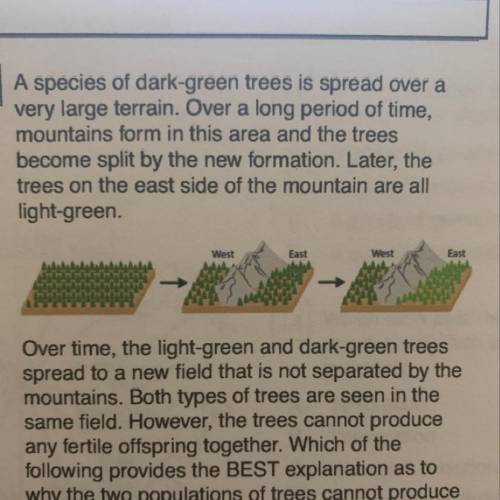
Biology, 14.07.2020 20:01 magalyrodette7812
A species of dark-green trees is spread over a
very large terrain. Over a long period of time,
mountains form in this area and the trees
become split by the new formation. Later, the
trees on the east side of the mountain are all
light-green.
Over time, the light-green and dark-green trees
spread to a new field that is not separated by the
mountains. Both types of trees are seen in the
same field. However, the trees cannot produce
any fertile offspring together. Which of the
following provides the BEST explanation as to
why the two populations of trees cannot produce
fertile offspring?
A. The trees on the west side of the mountain
retained their original phenotype that became
unique to their population.
B. The trees on the east side of the mountain
developed a new phenotype, which made them
unable to produce fertile offspring.
C. The trees on the east side of the mountain
experienced many genetic mutations and
recombinations unique to their population.
D. The trees on the west side of the mountain
could not adapt to the new barrier, which made
them unable to produce fertile offspring.


Answers: 3


Another question on Biology



Biology, 22.06.2019 12:30
Which of the following is true of metabolism in its entirety in all organisms? a) metabolism depends on a constant supply of energy from food. b) metabolism uses all of an organism's resources. c) metabolism consists of all the energy transformation reactions in an organism. d) metabolism manages the increase of entropy in an organism.
Answers: 1

Biology, 22.06.2019 21:00
The term autotroph refers to an organism that: a. uses co2 for its carbon source. b. must obtain organic compounds for its carbon needs. c. gets energy from sunlight. d. gets energy by oxidizing chemical compounds. e. does not need a carbon source
Answers: 3
You know the right answer?
A species of dark-green trees is spread over a
very large terrain. Over a long period of time,
Questions


History, 18.07.2019 03:00

Biology, 18.07.2019 03:00



Mathematics, 18.07.2019 03:00


Mathematics, 18.07.2019 03:00


English, 18.07.2019 03:00

Biology, 18.07.2019 03:00

Social Studies, 18.07.2019 03:00

Social Studies, 18.07.2019 03:00


Biology, 18.07.2019 03:00


History, 18.07.2019 03:00

Mathematics, 18.07.2019 03:00


Biology, 18.07.2019 03:00



